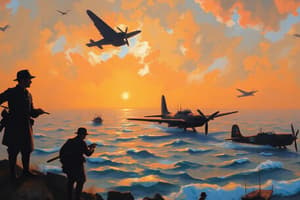Podcast
Questions and Answers
Stalin believed the United States and Great Britain were ready to launch a full-scale invasion of Europe right away.
Stalin believed the United States and Great Britain were ready to launch a full-scale invasion of Europe right away.
False (B)
The US invaded Morocco and Algeria primarily to gain territory that it could then colonize.
The US invaded Morocco and Algeria primarily to gain territory that it could then colonize.
False (B)
The Suez Canal was important to Britain because it provided a route to its empire.
The Suez Canal was important to Britain because it provided a route to its empire.
True (A)
Losing the Suez Canal would have had little impact on Britain.
Losing the Suez Canal would have had little impact on Britain.
General Patton commanded American forces in Algeria during Operation Torch.
General Patton commanded American forces in Algeria during Operation Torch.
Operation Torch was commanded by General Dwight D. Eisenhower.
Operation Torch was commanded by General Dwight D. Eisenhower.
The Americans trapped Rommel between two Allied forces in Tunisia.
The Americans trapped Rommel between two Allied forces in Tunisia.
The Battle of Kasserine Pass was a decisive American victory.
The Battle of Kasserine Pass was a decisive American victory.
The dimming of lights on the East Coast was implemented to protect cargo ships.
The dimming of lights on the East Coast was implemented to protect cargo ships.
After Kasserine Pass, Eisenhower put Patton in command.
After Kasserine Pass, Eisenhower put Patton in command.
The convoy system involved cargo ships traveling alone without any protection.
The convoy system involved cargo ships traveling alone without any protection.
The last German forces in North Africa surrendered in 1944.
The last German forces in North Africa surrendered in 1944.
The convoy system worsened the situation for American cargo ships.
The convoy system worsened the situation for American cargo ships.
German submarines did not enter American coastal waters during the Battle of the Atlantic.
German submarines did not enter American coastal waters during the Battle of the Atlantic.
In May and June, over 2.0 million tons of shipping were sunk.
In May and June, over 2.0 million tons of shipping were sunk.
In the spring of 1942, the German submarine campaign was at its highest point.
In the spring of 1942, the German submarine campaign was at its highest point.
After July 1942, Germany produced more ships than American submarines managed to sink.
After July 1942, Germany produced more ships than American submarines managed to sink.
Radar, sonar, and depth charges are examples of new technologies used to attack submarines.
Radar, sonar, and depth charges are examples of new technologies used to attack submarines.
The Battle of the Atlantic gradually favored the Axis powers due to the use of new technology.
The Battle of the Atlantic gradually favored the Axis powers due to the use of new technology.
In 1942, Adolf Hitler was not confident he would win the war.
In 1942, Adolf Hitler was not confident he would win the war.
Hitler believed destroying the Soviet economy was key to defeating the Soviet Union.
Hitler believed destroying the Soviet economy was key to defeating the Soviet Union.
In 1942, German submarines were sinking American ships.
In 1942, German submarines were sinking American ships.
The German army aimed to launch an offensive to remove the Soviets from the war.
The German army aimed to launch an offensive to remove the Soviets from the war.
Stalingrad was not a major railroad junction.
Stalingrad was not a major railroad junction.
Capturing Stalingrad would have cut off the Soviets from vital resources.
Capturing Stalingrad would have cut off the Soviets from vital resources.
Stalin permitted his troops to retreat from Stalingrad.
Stalin permitted his troops to retreat from Stalingrad.
The Battle of Midway put the Germans on the defensive for the remainder of the war.
The Battle of Midway put the Germans on the defensive for the remainder of the war.
Flashcards
Joseph Stalin
Joseph Stalin
Soviet leader who urged Roosevelt to open a second front in Europe.
Second Front
Second Front
Opening a western attack on Germany to relieve Soviet forces.
Churchill's Strategy
Churchill's Strategy
He wanted to attack the edges of the German Empire.
Morocco and Algeria
Morocco and Algeria
Signup and view all the flashcards
Invasion Reasons
Invasion Reasons
Signup and view all the flashcards
Suez Canal
Suez Canal
Signup and view all the flashcards
Suez Canal Importance
Suez Canal Importance
Signup and view all the flashcards
Churchill's Caution
Churchill's Caution
Signup and view all the flashcards
Convoy System
Convoy System
Signup and view all the flashcards
Convoy System Effectiveness
Convoy System Effectiveness
Signup and view all the flashcards
Peak of German Submarine Campaign
Peak of German Submarine Campaign
Signup and view all the flashcards
Turning Point in Ship Production
Turning Point in Ship Production
Signup and view all the flashcards
New Allied Technologies
New Allied Technologies
Signup and view all the flashcards
The Battle of the Atlantic
The Battle of the Atlantic
Signup and view all the flashcards
East Coast Blackouts
East Coast Blackouts
Signup and view all the flashcards
Convoy Purpose
Convoy Purpose
Signup and view all the flashcards
Afrika Korps
Afrika Korps
Signup and view all the flashcards
Erwin Rommel
Erwin Rommel
Signup and view all the flashcards
Operation Torch
Operation Torch
Signup and view all the flashcards
George Patton
George Patton
Signup and view all the flashcards
Battle of Kasserine Pass
Battle of Kasserine Pass
Signup and view all the flashcards
George Patton
George Patton
Signup and view all the flashcards
May 13, 1943
May 13, 1943
Signup and view all the flashcards
Battle of the Atlantic
Battle of the Atlantic
Signup and view all the flashcards
Hitler's Confidence in 1942
Hitler's Confidence in 1942
Signup and view all the flashcards
1942 German Eastern Front Offensive
1942 German Eastern Front Offensive
Signup and view all the flashcards
Stalingrad's Importance
Stalingrad's Importance
Signup and view all the flashcards
Consequences of Losing Stalingrad
Consequences of Losing Stalingrad
Signup and view all the flashcards
Stalin's 'No Retreat' Order
Stalin's 'No Retreat' Order
Signup and view all the flashcards
Stalingrad's Urban Warfare
Stalingrad's Urban Warfare
Signup and view all the flashcards
Soviet Counter-Offensive at Stalingrad
Soviet Counter-Offensive at Stalingrad
Signup and view all the flashcards
Significance of Stalingrad outcome
Significance of Stalingrad outcome
Signup and view all the flashcards
Study Notes
- The US entered the war, Joseph Stalin urged President Roosevelt to open a second front in Europe.
- In 1942 Allied forces started winning victories in Europe.
- Stalin wanted British and American troops to open a western front to alleviate pressure on the Soviet Union.
Strategy Disagreement
- Churchill did not believe the United States and Great Britain were ready for a full-scale European invasion.
- Churchill wanted to attack the periphery of the German empire instead.
- Roosevelt wanted to get American troops into battle in Europe.
- Churchill urged caution.
- Roosevelt agreed with Churchill's plan.
- In July 1942, he ordered the invasion of Morocco and Algeria, two French territories under German control.
Reasons for Invasion
- The invasion gave the army experience without needing many troops.
- American troops in North Africa could help British troops fighting Germans in Egypt.
Importance of the Suez Canal
- Most of Britain's empire used the Suez Canal to send supplies to Britain.
- Included India, Hong Kong, Singapore, Malaya, and Australia.
- Egypt was very important to Britain for this reason.
- Britain would be devastated if it lost the canal.
German Forces in Africa
- The German forces were known as the "Afrika Korps."
- Commanded by General Erwin Rommel, nicknamed "Desert Fox".
- The British forced Rommel to retreat at the Battle of El Alamein.
- Rommel's forces remained a serious threat.
Operation Torch
- On November 8, 1942, the American invasion of North Africa began.
- Commanded by General Dwight D. Eisenhower.
- American forces in Morocco, led by General George Patton, captured Casablanca.
- Forces in Algeria seized Oran and Algiers.
- Americans headed east into Tunisia.
- British forces headed west into Libya.
- The plan was to trap Rommel between the two Allied forces.
Battle of Kasserine Pass
- American troops advanced into the mountains of western Tunisia and fought the German army for the first time.
- The Americans were outmaneuvered and outfought.
- They suffered about 7,000 casualties and lost nearly 200 tanks.
Allied Victory in North Africa
- Eisenhower fired the general who led the attack.
- Patton was put in command.
- The American and British forces pushed the Germans back.
- On May 13, 1943, the remaining German forces in North Africa surrendered.
The Battle of the Atlantic
- As American and British troops fought the German army in North Africa, the fight against German submarines in the Atlantic Ocean continued.
- German submarines targeted American cargo ships in American coastal waters.
- Cities on the East Coast dimmed their lights every evening to protect the ships.
Convoy System Implementation
- By August 1942, German submarines sunk about 360 American ships along the American coast.
- The losses convinced the U.S. Navy to set up a convoy system.
- Cargo ships traveled in groups and were escorted by navy warships.
- This improved the situation dramatically.
- It became hard for submarines get close enough to torpedo a cargo ship and escape without being attacked.
Effect of Mobilization for War
- In May and June, over 1.2 million tons of shipping were sunk.
- American and British shipyards built 1.1 million tons of new shipping during that time.
- From July 1942 onward, American shipyards were producing more ships than German submarines managed to sink.
New Technologies and Turn of Tides
- American airplanes and warships began to use new technology, including radar, sonar, and depth charges, to locate and attack submarines.
- The Battle of the Atlantic slowly turned in favor of the Allies.
Overall German War Situation in 1942
- Rommel's troops were pushing the British back in Egypt.
- German submarines were sinking American ships.
- The German army was preparing a new offensive to knock the Soviets out of the war.
- In the spring of 1942, before the situation changed Hitler was confident in a German Victory.
- Hitler believed that destroying the Soviet Union's economy was the only way to defeat them.
City of Stalingrad
- In May 1942, Hitler ordered his army to capture strategic oil fields, industries, and farmlands in southern Russia and Ukraine.
- Stalingrad controlled the Volga River and was a major railroad junction.
- Capturing Stalingrad would cut off the Soviets from needed resources .
- In mid-September, German troops entered Stalingrad.
- Stalin ordered his troops to hold the city at all cost.
- Retreat was forbidden.
- The Germans were forced to engage in house-to-house fighting, losing thousands of soldiers.
Battle of Stalingrad Outcome
- On November 23, Soviet reinforcements arrived and surrounded Stalingrad.
- Almost 250,000 German troops were trapped.
- When the battle ended, 91,000 Germans surrendered.
- Only 5,000 of them survived Soviet prison camps and returned home after the war.
- The Battle of Stalingrad marked a major turning point in the war, putting the Germans on the defensive.
- The Battle of Midway put the Japanese on the defensive, similarly.
Studying That Suits You
Use AI to generate personalized quizzes and flashcards to suit your learning preferences.




